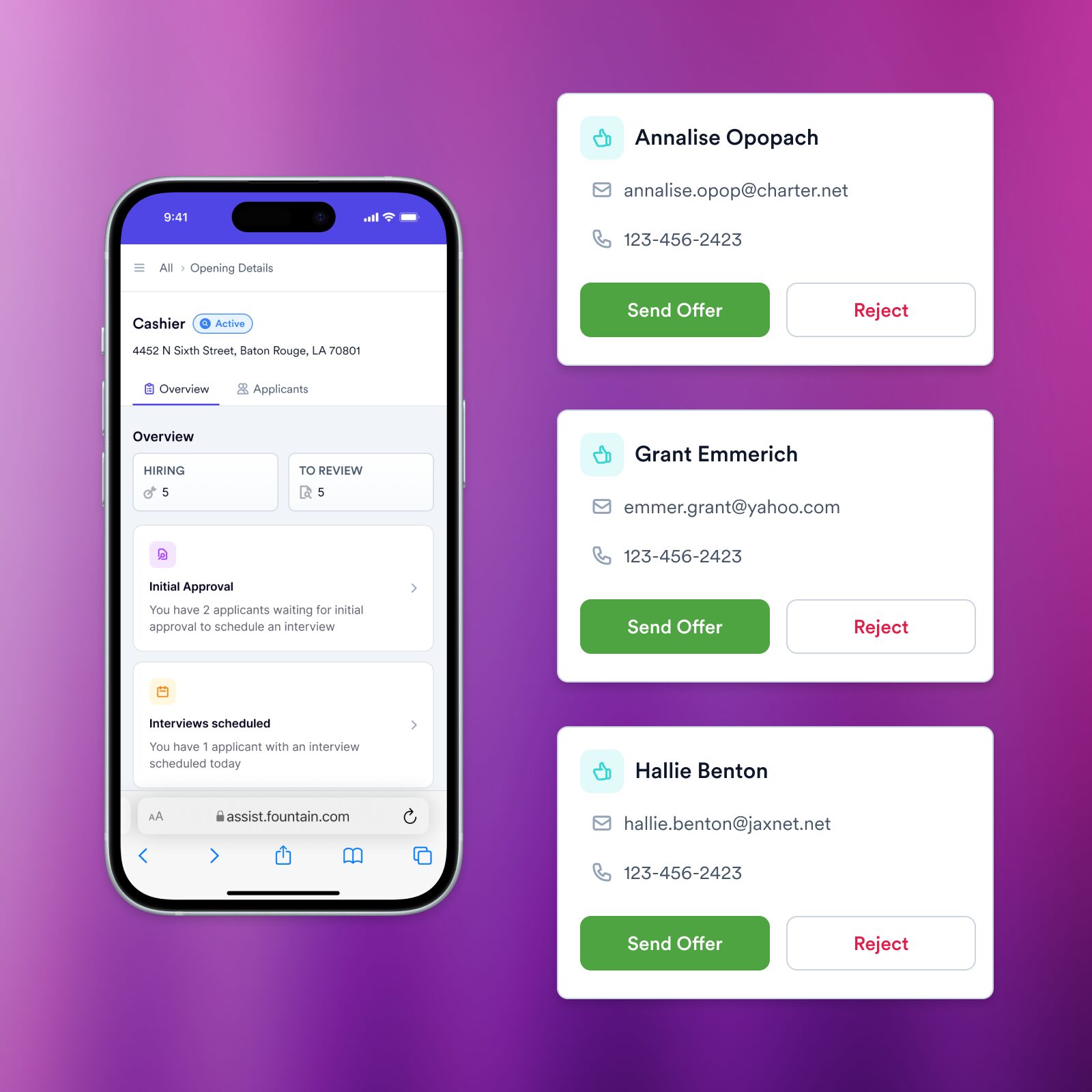Sourcing is one of the most time-consuming and costly tasks in recruiting. For some, regular high turnover is just part of the territory. Others may only worry about filling a position when someone suddenly quits. For all companies, candidate sourcing strategies have become a competition of who has the bigger budget or larger recruiting staff.
But you’re in luck! There are ways to game the sourcing system. If you’re a small company, have a limited budget, or are simply new to the world of sourcing, this is especially for you.
The candidate sourcing process in a nutshell
Candidate sourcing used to mean posting job openings in various places and seeing who responded, but with this strategy, only candidates who were actively looking for work were targeted. To stay competitive and reach applicants who may not be in the market for a new job (i.e., “passive” job seekers) companies had to be proactive in their sourcing efforts.
The person or team responsible for the different methods of sourcing candidates will perform the following tasks:
- Post job openings on the relevant platforms.
- Collect the candidates’ application forms, resumes, and samples of work.
- Determine whether the candidates are suitable to progress through the hiring process, by conducting pre-employment screening.
- Communicate with candidates about new job opportunities.
- Nurture relationships with people who are not ready to leave their existing jobs immediately.
Why effective talent sourcing matters
When you hire the right people, you’ll notice your company’s productivity pick up, which can boost your bottom line. You also might notice a more positive work culture, which can affect morale and keep workers around longer.

On the other hand, if your sourcing efforts bring in the wrong candidates, you’ll waste time, and resources and may even lose out on business opportunities.
15 strategies that work for sourcing candidates
Consider implementing any or all of these sourcing strategies to identify and attract the best people to join your company.
1. Develop a pipeline for talent pool sourcing
With your ATS at the ready, you can build a pipeline of talented and qualified individuals who are ready to work. This also means you can reduce the likelihood of facing a staff shortage since you’ll have a pool to pull from.
Although you may not have any current vacancies, having a full pipeline will ensure that you are ready to source and recruit as the need arises.
Candidates can be added to your pipeline even if they’re currently employed but aren’t quite ready to move on to a new opportunity. You can use message automation to nurture the relationship with candidates in your pipeline so that when they are ready to move on, your company will be at the top of their minds.
2. Leverage online resume searches for effective candidate sourcing
Many people now post their portfolios and resumes online. They might even create their own website to display their work and include images, files, and/or an “about” page to attract potential employers. This is popular among professionals in the tech industry, creative arts, or other types of contingency workers. This applicant sourcing strategy is ideal for sourcing passive candidates.
3. Establish an employee referral program
Employee referrals are an effective option for your candidate sourcing strategy. Referrals yield above-average candidates, have the highest interview-to-hire ratio, and are less likely to leave the job, which will have a positive effect on your staff turnover rates.
To incentivize employee referrals, offer an incentive program for employees who refer a candidate who goes on to be hired.

4. Reach out to people who didn’t get the job the first time
When you are in the recruitment process, you may have dozens, if not hundreds, of candidates with only one position to fill. There is most likely more than one qualified candidate. Use your applicant tracking system (ATS) to retain information about suitable candidates. If a similar position opens up again, contact some suitable candidates from the last round of interviews.
This strategy will help to reduce your time-to-hire rates and cultivate a pool of qualified candidates.
5. Use the best sourcing tools for your employee sourcing strategies
The sourcing tool you use should be suited to the type of business you are recruiting for. For example, if you recruit for franchises, the tool you choose should be capable of handling numerous applications at one time, without compromising the quality of the application.
Learn how one recruiter is able to effectively manage nearly 2,000 candidates when hiring employees for one of the biggest fast food chains.
Read more: Free candidate sourcing tools
6. Include passive candidates in your applicant sourcing strategies
If you find an interesting candidate but do not have an open position, retain their information in case a suitable position becomes available in the future.
Even if the person you are interested in is currently employed, go ahead and reach out to them.
7. Host events to get people engaged in person
Events are a different type of sourcing strategy that are not often leveraged through the recruiting process. You can choose how formal or informal these events are. They can be anything from a bowling night with some Q&A time to a tour of the facilities with one-on-one interviews to follow.
A traditional job fair can sometimes be just what you need in your candidate sourcing strategy. The people who attend these events are people who probably already know your company and have been waiting for an opportunity to work with you.
8. Leverage perks, benefits, and salary in your candidate sourcing strategies
Research shows that being transparent about salaries and benefits not only saves you time, it significantly increases engagement with the job posting. Including this information can increase engagement by up to 30%. Ultimately, your chances of finding a good candidate are increased by your willingness to be transparent about your salary and benefits.
9. Boost your applicant sourcing strategies by using your website
If you have a quality website with high traffic and engagement, use this to your advantage. Repeat visitors already know about your company and are choosing to support it. They are likely to be involved in a similar industry or, at the very least, have an interest in it.
This candidate sourcing strategy will open up the candidate pool to include people who are already passionate about your product or service. Including the job ad on your careers page will give your supporters a chance to work for your business.
10. Use good outbound messages
If you are sourcing passive candidates, make sure that the initial message that you send them is well-written. The first line of contact is the subject line of the email. Make sure that it is engaging and will entice the candidate to open the message.

Keep the applicant sourcing message personalized. Make sure that the candidate knows that you are interested in them specifically. They will be less likely to answer if they think you sent the same message to 50 other candidates.
Asking for personalized information will also help you understand the candidate’s needs and offer them what they want. Ask questions like, “What do you look for in a career?” or “What is holding you back from switching employers?” By asking about them personally, you show them that you really value their experience.
Read more: How to source for candidates and all the considerations
11. Source with a good job description
A good job description is the bread and butter of effective candidate sourcing strategies. If you cannot describe the position that you are hiring for and the candidate qualifications that you value, this will negatively affect engagement with your job description.
Keep in mind that different companies might refer to the same job using different titles. Review all possible job titles and choose the one you feel best matches the duties and qualifications you outlined to ensure that you find the widest pool of candidates.
Here are some things to consider when writing effective job descriptions:
- Avoid job titles that you use internally (i.e., Member Service Representative).
- Use words that people will search for.
- Keep it between 700 and 2,000 words. According to an Indeed study, descriptions in this range receive 30% more applications on average.
- Give them an idea of what it is like to work with you. Include descriptions of day-to-day responsibilities, workplace culture, and how the job relates to the rest of the business.
- Ensure that your description is accurate and covers all of the necessary information, by having someone who is already in that position read over the description and make suggestions for edits.
12. Follow up every time
While you are sourcing passive candidates, it is important to stay on your candidate’s radar by congratulating them on their accomplishments, asking them about projects that you have discussed, or inquiring about their satisfaction with their current employment.
Your candidate may not have responded to your first contact attempt, but by messaging them every so often, you remind them that the opportunity to discuss a new position is still open. You can communicate to them that you have not forgotten them and are still interested in working with them in the future. Do not pressure them to make any changes. Just remind them that your company is an option for them.
13. Use social media platforms
To help develop your brand, utilize social media platforms. Through this medium, you can talk about how your company started, what your mission statement is, and what you are hoping to do next in an organic way. Interested candidates will be able to engage with your content and ask questions.
This also supports a strong company brand. An effective social media profile will show potential candidates what you are all about and get them excited about the idea of working with you.
14. Leverage internal recruiting for your recruitment sourcing strategies.
There are situations where it makes sense to hire from within. If you are a small business or working on a tight budget, it will save you money in the recruiting process that you might otherwise spend on training costs, job posting fees, and background check fees. If you are working on a complex project, it may be better to promote or transfer someone who already has knowledge of the project.

This candidate sourcing strategy will also show your current employees that you are invested in their development. Most people stay with a company longer if they believe that there is room for them to be promoted to better positions. Giving them opportunities to do this will decrease turnover.
15. Provide a superior candidate experience
The recruitment process should be equally as seamless for both you and the candidate.
Manage your recruitment process using an ATS that supports the features and functions below, making it a breeze for applicants to become candidates and get hired.
- Workflows and stages—Allocate different workflows for every job you post.
- Screening—Conduct background checks and other pre-employment screening requirements.
- Team management—Control access and permission for different team members.
- Integrations—Integrate seamlessly with other sourcing and recruitment tools, like electronic signature software and pre-employment screening services to provide an end-to-end recruitment solution.
Tips to consider when sourcing candidates
The applicant sourcing strategies you use will be dependent on different organizational factors, like the number of candidates you need to recruit, budget, and role. This will help you decide which strategies will work best for proactively finding and engaging the right people.
Here are some tips to help you get on the right track:
- Allow enough time to search for the right candidate. It may end up saving you time in the long run. The first batch of candidates may be suitable for the role, but applicants who apply later may be an even better fit.
- Go beyond the boards. Having multiple channels for finding talent also allows recruiters to cast wider nets. It can also help you acquire better talent for less overall spend.
- Consider the number of vacancies you’re filling. The number of vacancies you have for a role will impact your talent sourcing strategy. If you’re a high turnover business, you may need to source a large number of candidates at one time.
- Keep your branding tight. Candidates are assessing you, too. Show everyone that you’re a great employer. You can achieve this by showcasing employee experiences. Offering meaningful benefits and perks, like health insurance.
- Keep communication channels open. Every candidate should receive an acknowledgment after they have submitted an application to your company–even if you are hiring thousands of candidates at one time. A reputation for poor communication might discourage future candidates from applying.
- Track and analyze your talent sourcing metrics. Use your ATS to identify which metrics are most important for you to meet. These might include interview attendance, applicant conversion, and drop-off rates. Time-to-hire is another crucial metric to track so you know how long it takes (on average) to hire a single candidate.
How Fountain can help
It is important to have the right tools to support your candidate sourcing strategy. For companies looking to cast a wider net to source applicants at a fraction of the cost of hiring an agency, Fountain’s Boost feature is an easy way to set a budget and just wait for candidates to come to you.
We deliver candidates to companies and they just worry about hiring. With a click of a button, Fountain sends job openings to free job boards.
We act as an agency without charging agency prices. You provide a budget and we will determine the best strategy. Sometimes it’s a mix between major job boards and ad networks or a larger portion of the budget dedicated to just one of these.
In turn, employers can just sit back and wait for applicants to come. Additionally, we don’t just make recommendations – we take action on your behalf. At the end of the day, employers don’t need to worry about how candidates got to them – they should just focus on getting a steady stream of qualified candidates.

